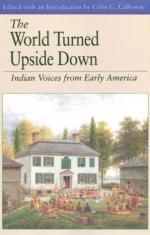|
This section contains 625 words (approx. 2 pages at 400 words per page) |

|
Chapter 4 Summary and Analysis
Indians were often caught in the middle of wars between Europeans, most famous in the French and Indian War of 1756 to 1763. As revealed in a 1758 speech by Delaware Indians, Indians believed that the English caused the war, making the title "French and Indian War" somewhat Anglo-centric, seeing how Indians were dragged into a conflict between two European nations. Indians were often called upon to fight for various sides, and Europeans often created intertribal conflicts, playing one tribe off the other for their own political gain.
The first text is from 1684, when a governor of New France named La Barre traveled to Iroquois country to try to bluff his way to making the Iroquois stop trading with the English. The Iroquois were quite dependent on the English for goods. An Onondaga named Garangula gives La Barre a speech, essentially calling his bluff...
(read more from the Chapter 4 Summary)
|
This section contains 625 words (approx. 2 pages at 400 words per page) |

|




